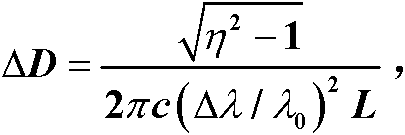Dispersion compensation method for broadband light source
A broadband light source, dispersion compensation technology, applied in the direction of eliminating distortion/dispersion, optical fiber transmission, electromagnetic wave transmission system, etc., can solve the problems of noise and error, inability to realize ultra-broadband optical signal, complex implementation device, etc., to achieve high test accuracy, Good real-time performance, good real-time effect
- Summary
- Abstract
- Description
- Claims
- Application Information
AI Technical Summary
Problems solved by technology
Method used
Image
Examples
Embodiment approach example 2
[0036] The 1310nm polarization-maintaining fiber used in the experiment generally has a very small birefringence dispersion coefficient, but when the fiber length is long, the birefringence dispersion of the fiber will make the interference light signal broaden more seriously. Therefore, in the experiment, a 1000m polarization-maintaining optical fiber was connected to the system. As described in Example 1 of the embodiment, it can be measured that there will be a large coupling point at 1000m. The envelope of coupled mode interference data is used for dispersion compensation, and the results before and after compensation are as follows Figure 5 As shown, it can be seen that after compensation, the width of the envelope of the interference data between the excited mode and the coupled mode at 1 / e is reduced from 373.07um to 39.93um.
Embodiment approach example 3
[0038] In order to further illustrate the importance of dispersion compensation when using a broadband light source as the light source of the test system, a 400m polarization-maintaining fiber is connected to the system, and an external force is applied at a distance of about 10cm from the joint between the 400m fiber and the polarizer. Case 1 and the principle of polarization coupling test, there will be a coupling point at 399.9m and 400m respectively, due to the long transmission distance, the envelopes of the interference data of the excited mode and the coupled mode at the two coupling points will widen and overlap to distinguish Not open, but the interference data envelope at the two coupling points after dispersion compensation is about 4.7 times narrower than that before compensation, so the two close coupling points can be easily distinguished. The results before and after compensation are as follows Image 6 shown.
PUM
 Login to View More
Login to View More Abstract
Description
Claims
Application Information
 Login to View More
Login to View More - R&D
- Intellectual Property
- Life Sciences
- Materials
- Tech Scout
- Unparalleled Data Quality
- Higher Quality Content
- 60% Fewer Hallucinations
Browse by: Latest US Patents, China's latest patents, Technical Efficacy Thesaurus, Application Domain, Technology Topic, Popular Technical Reports.
© 2025 PatSnap. All rights reserved.Legal|Privacy policy|Modern Slavery Act Transparency Statement|Sitemap|About US| Contact US: help@patsnap.com



